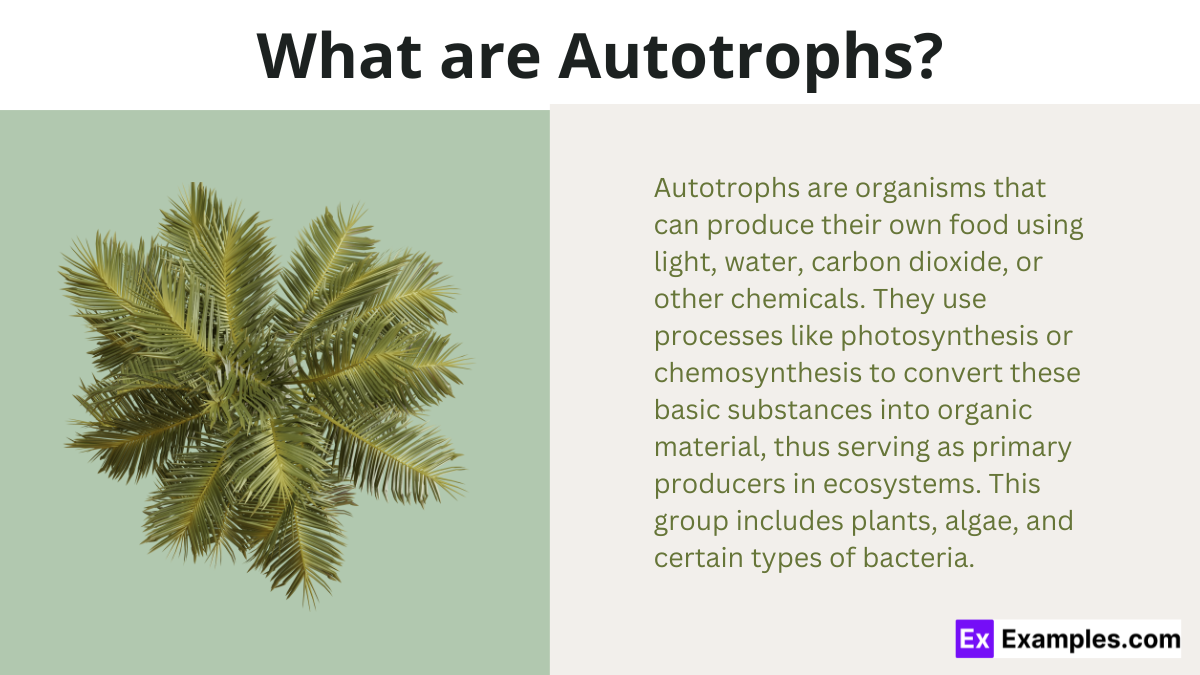What is an autotroph?
An organism that eats other organisms
An organism that produces its own food
An organism that decomposes organic material
An organism that relies on others for food

Autotrophs are organisms that can create their own food using light, water, carbon dioxide, or other chemicals. This unique ability allows them to sustain themselves without the need to consume other organisms, distinguishing them as fundamental producers within ecosystems.
Autotrophs are living entities that synthesize their own nutrients through processes like photosynthesis or chemosynthesis. Using energy from sunlight or chemical reactions, they convert simple substances from their environment into complex energy-rich molecules, providing the foundation for the majority of life on Earth.
Autotrophs, organisms that produce their own food, are categorized primarily based on their source of energy for synthesis. They fall into two main types: Photoautotrophs and Chemoautotrophs.
Photoautotrophs are organisms that convert light energy from the sun into chemical energy through photosynthesis. This group includes most plants, algae, and some bacteria like cyanobacteria. They use chlorophyll or other pigments to capture light, combining carbon dioxide (CO2) and water (H2O) to produce glucose, a simple sugar, and oxygen (O2) as a byproduct. This process is fundamental to life on Earth, contributing to the oxygen-rich atmosphere and serving as a primary energy source for most ecosystems.
Chemoautotrophs are less common but equally fascinating. These organisms synthesize organic compounds using chemical energy derived from inorganic substances, not relying on sunlight. They are mostly found in extreme environments such as hydrothermal vents on the ocean floor, hot springs, or sulfur-rich volcanic areas. Chemoautotrophs oxidize inorganic molecules like hydrogen sulfide (H2S), ammonia (NH3), or ferrous ions (Fe2+) to obtain energy, which they then use to fix CO2 into organic compounds. This ability allows them to thrive in environments where sunlight cannot penetrate, making them key players in deep-sea ecosystems and the global carbon cycle.
Autotrophs key points
Autotrophs, also known as producers, form the foundation of the food chain in ecosystems around the world. They harness energy from the sun through photosynthesis or from chemical reactions through chemosynthesis, converting inorganic substances into organic matter that serves as food for heterotrophic organisms (consumers). This unique ability allows autotrophs to produce their own energy and nutrients, which are then passed through the food chain to herbivores, carnivores, and decomposers.
In terrestrial ecosystems, plants are the primary autotrophs, capturing solar energy and carbon dioxide to produce oxygen and glucose. This process not only supports the life of the plant but also provides essential nutrients to herbivores that feed on plants. In aquatic ecosystems, phytoplankton and algae serve a similar role, supporting a diverse range of marine life from small fish to large mammals.
Autotrophs are crucial for maintaining the balance of ecosystems. They help regulate atmospheric CO2 levels, contribute to the oxygen we breathe, and ultimately support all life forms by initiating the flow of energy through the food web. Their presence and health are indicators of an ecosystem’s productivity and stability, highlighting the interconnectedness of life on Earth.
Autotrophs produce food through photosynthesis or chemosynthesis, converting sunlight or chemical energy into organic compounds.
Autotrophs are crucial for ecosystems, providing the primary source of organic matter and oxygen for heterotrophic organisms.
Yes, aquatic autotrophs include phytoplankton and algae, vital for oxygen production and food web support in water ecosystems.
No, while many use photosynthesis, some autotrophs utilize chemosynthesis, especially in environments without sunlight.
Most plants are autotrophs, using photosynthesis to produce food, but there are exceptions like some parasitic plants.
Autotrophs impact the environment by producing oxygen, sequestering carbon dioxide, and forming the foundation of food webs.
Autotrophs produce their own food from inorganic sources, whereas heterotrophs rely on consuming other organisms for energy.
Text prompt
Add Tone
What is Meant by Autotrophs?
Types of Autotrophs
What is an autotroph?
An organism that eats other organisms
An organism that produces its own food
An organism that decomposes organic material
An organism that relies on others for food
Which of the following is an example of an autotroph?
Mushroom
Human
Fern
Dog
Autotrophs are primarily involved in which biological process?
Fermentation
Respiration
Photosynthesis
Predation
Which of these organisms is a photosynthetic autotroph?
Yeast
Amoeba
Cyanobacteria
Earthworm
Chemosynthetic autotrophs obtain their energy from:
Inorganic chemicals
Organic compounds
Sunlight
Other organisms
Which part of the plant is primarily responsible for photosynthesis?
Roots
Stems
Leaves
Flowers
The primary pigment involved in photosynthesis is:
Hemoglobin
Melanin
Chlorophyll
Carotene
Which gas is a byproduct of photosynthesis?
Carbon dioxide
Oxygen
Methane
Nitrogen
Which molecule is the main energy source produced during photosynthesis?
ATP
Glucose
Starch
Protein
Which of the following is NOT an autotroph?
Algae
Moss
Cactus
Fungi
Before you leave, take our quick quiz to enhance your learning!

